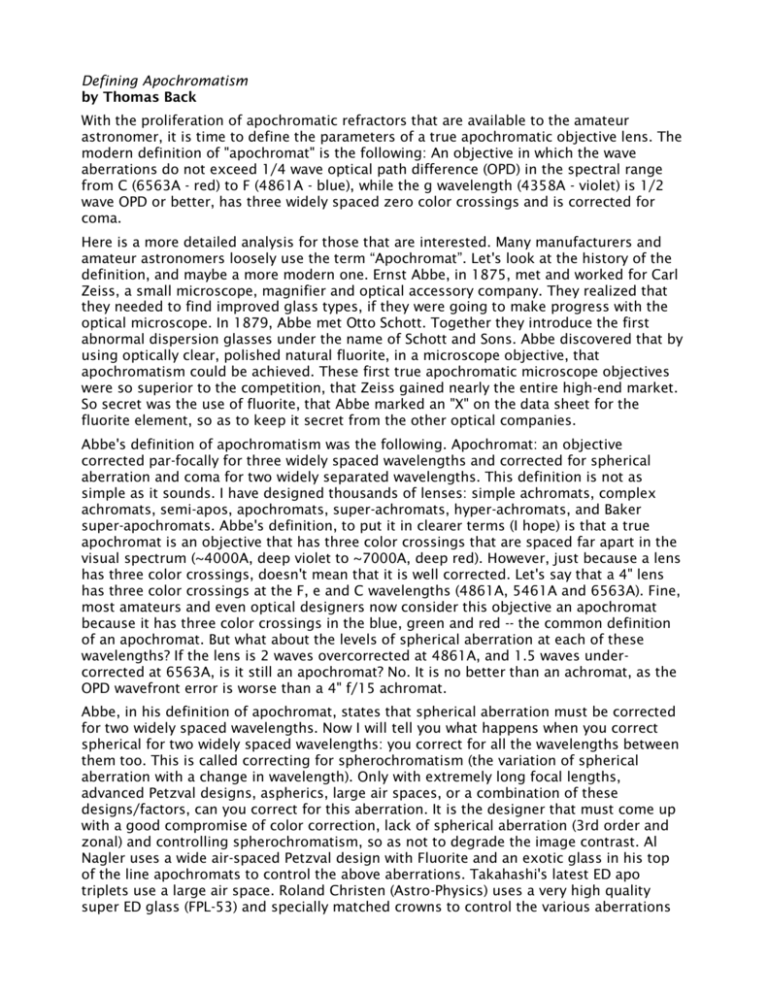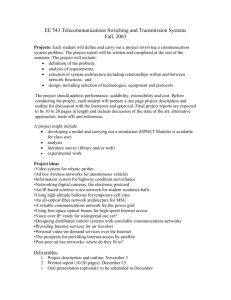Defining Apochromatism
advertisement

Defining Apochromatism by Thomas Back With the proliferation of apochromatic refractors that are available to the amateur astronomer, it is time to define the parameters of a true apochromatic objective lens. The modern definition of "apochromat" is the following: An objective in which the wave aberrations do not exceed 1/4 wave optical path difference (OPD) in the spectral range from C (6563A - red) to F (4861A - blue), while the g wavelength (4358A - violet) is 1/2 wave OPD or better, has three widely spaced zero color crossings and is corrected for coma. Here is a more detailed analysis for those that are interested. Many manufacturers and amateur astronomers loosely use the term “Apochromat”. Let's look at the history of the definition, and maybe a more modern one. Ernst Abbe, in 1875, met and worked for Carl Zeiss, a small microscope, magnifier and optical accessory company. They realized that they needed to find improved glass types, if they were going to make progress with the optical microscope. In 1879, Abbe met Otto Schott. Together they introduce the first abnormal dispersion glasses under the name of Schott and Sons. Abbe discovered that by using optically clear, polished natural fluorite, in a microscope objective, that apochromatism could be achieved. These first true apochromatic microscope objectives were so superior to the competition, that Zeiss gained nearly the entire high-end market. So secret was the use of fluorite, that Abbe marked an "X" on the data sheet for the fluorite element, so as to keep it secret from the other optical companies. Abbe's definition of apochromatism was the following. Apochromat: an objective corrected par-focally for three widely spaced wavelengths and corrected for spherical aberration and coma for two widely separated wavelengths. This definition is not as simple as it sounds. I have designed thousands of lenses: simple achromats, complex achromats, semi-apos, apochromats, super-achromats, hyper-achromats, and Baker super-apochromats. Abbe's definition, to put it in clearer terms (I hope) is that a true apochromat is an objective that has three color crossings that are spaced far apart in the visual spectrum (~4000A, deep violet to ~7000A, deep red). However, just because a lens has three color crossings, doesn't mean that it is well corrected. Let's say that a 4" lens has three color crossings at the F, e and C wavelengths (4861A, 5461A and 6563A). Fine, most amateurs and even optical designers now consider this objective an apochromat because it has three color crossings in the blue, green and red -- the common definition of an apochromat. But what about the levels of spherical aberration at each of these wavelengths? If the lens is 2 waves overcorrected at 4861A, and 1.5 waves undercorrected at 6563A, is it still an apochromat? No. It is no better than an achromat, as the OPD wavefront error is worse than a 4" f/15 achromat. Abbe, in his definition of apochromat, states that spherical aberration must be corrected for two widely spaced wavelengths. Now I will tell you what happens when you correct spherical for two widely spaced wavelengths: you correct for all the wavelengths between them too. This is called correcting for spherochromatism (the variation of spherical aberration with a change in wavelength). Only with extremely long focal lengths, advanced Petzval designs, aspherics, large air spaces, or a combination of these designs/factors, can you correct for this aberration. It is the designer that must come up with a good compromise of color correction, lack of spherical aberration (3rd order and zonal) and controlling spherochromatism, so as not to degrade the image contrast. Al Nagler uses a wide air-spaced Petzval design with Fluorite and an exotic glass in his top of the line apochromats to control the above aberrations. Takahashi's latest ED apo triplets use a large air space. Roland Christen (Astro-Physics) uses a very high quality super ED glass (FPL-53) and specially matched crowns to control the various aberrations (he also slightly aspherizes the outer surfaces). TMB Optical uses Russian OK-4 super ED glass (similar to FPL-53) with an outer crown and a special dense crown glass, using air spacing with different internal radii, and hand figuring to control these aberrations. Also, the Abbe condition of coma correction is overstated, that is, if a lens is well corrected for coma at one wavelength, in almost all cases it will be corrected for coma at all the visual wavelengths. Now you might ask, after all this, just what is a modern definition of apochromatism? Well, as you read, it is not only three color crossings. One of the first things an optical designer discovers is that with catalog glass data, it is easy to design lenses with three or even four color crossings (super-achromat). But when you get 6 place data, these designs often breakdown to only two or three color crossings (that is not to say that a 4 color crossing objective cannot be made -- it can), albeit with the chromatic focal shift being very small. What are really important is how small the chromatic focal shift is (not the zero crossings) over a wide spectral range, and how low the spherical aberration is over that same range. So we are left with an ambiguous definition. After designing, testing and selling many different apochromatic lenses I can state this: There is no "definite" line where a lens becomes "apochromatic" in the world of commercial apochromatic lenses. But any lens, be it a doublet, triplet, quad, air-spaced or Petzval, that has a peak visual null (~5550A - the green-yellow) with a Strehl ratio of .95 or better, coma corrected and is diffraction limited from C (red) to F (blue) with 1/4 wave OPD spherical or better, has good control of the violet g wavelength with no more than 1/2 wave OPD P-V spherical and optical spot sizes that concentrate the maximum amount of photons within the diffraction limit -- a result of the low spherical aberration, which can be seen with modern optical design programs, as the "spot rays" will be seen concentrated in the center of the spot, not evenly or worse, concentrated outside the center -- will satisfy the modern definition of "Apochromatism." Lenses of this quality do not satisfy the Abbe definition, but for all intents and purposes, will be color free and will give extremely sharp and contrasty images. Thomas M. Back TMB Optical





